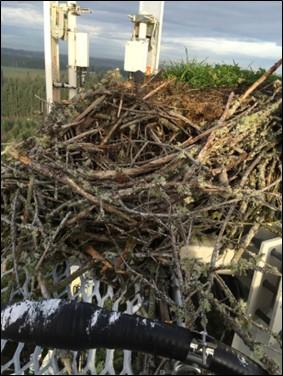Providing Recreation Opportunities
Dungeness Hunting Point: Wildlife Area Manager Laushman and Biologist Ament prepared the River’s End site of the Dungeness Unit for waterfowl hunting season and refreshed safety signage at the Helen’s Pond site.

Providing Conflict Prevention and Education
Osprey On Cell Towers: Biologist Tirhi worked on three permit requests for osprey nest removals on cell towers in Olympia, Lake Tapps, and Vaughn. Companies can legally remove nests from cell towers outside the active nesting season, on inactive sites, or sites finished for the season using a permit issued by Washington State Department of Fish and Wildlife.


Conserving Natural Landscapes
South Puget Sound Prairies: Biologists Tirhi participated in an all-day workshop hosted by Washington State University extension (Thurston County) and held at Thurston Conservation District to discuss conservation easements for remnant prairies of South Puget Sound. Conservation easements are a tool widely used in habitat conservation whereby private lands are retained by the landowner, but certain uses of that land are bought so that those uses cannot be implemented on the site. Uses usually include removing the ability to convert the habitat to other uses like pavement, buildings, and infrastructure but might also dictate activities like grazing, farming, and water use.
The workshop was geared at introducing Northwest Rangeland Trust, a rancher-lead non-profit land trust based in northeast Oregon. This land conservancy currently owns two conservation easements in Thurston County and may be available to purchase more, particularly on working lands having remnant prairie. Significant funds will soon become available for remnant prairie land acquisition (including conservation easements) and listed prairie species enhancement through the Thurston County Habitat Conservation Plan and Department of Defense, Joint Base Lewis-McCord (JBLM) Readiness and Environmental Integration (REPI) program.
Read more about the Habitat Conservation Plan here and the JBLM REPI program here. Other local land trusts are also poised to participate in expanding their capacity and acquisitions through this funding. Trusts such as Capitol Land Trust, Community Farm Land Trust, and South of the Sound Community Farm Land Trust have a long history of successful land conservation in the South Puget Sound and do exceptional work. One thing is certain, it will take all partners working together to conserve remnant prairie and recover listed prairies species in the South Sound region.

Providing Education and Outreach
Theler Wetlands Restoration Public Meeting: Washington Department of Fish and Wildlife and Hood Canal Salmon Enhancement Group held a public meeting at the Salmon Center in Belfair to present future restoration work at the Theler Wetlands. Plans for removal of a breached levee, restoration of the natural estuary, and a future boardwalk to connect the walking trails were presented, followed by a question and answer session. The next public meeting will be on Wednesday, Oct. 18 from 4:30 p.m. to 5:30 p.m. at the North Mason Timberland Library in Belfair.
South Puget Sound Wildlife Area Work Party: A volunteer opportunity is coming up for interested participants at the South Puget Sound Unit in Lakewood, on Oct. 7 from 9 a.m. to 1 p.m. Activities will include planting native plants, pulling Scotch broom, preparing a restoration area for plantings and signage, and pruning trees. Contact Katie Laushman with any questions.
Conducting Business Operations and Policy
Nisqually Indian Tribe Co-management: Biologist Tirhi arranged a collaboration meeting with Washington State Department of Fish and Wildlife (WDFW) Regions 5 and 6 Wildlife Program staff members, Nisqually Indian Tribe Wildlife Program Manager Borrego, U.S. Fish and Wildlife Service partners, and WDFW Wolf Specialist Lead Maletzke to discuss and plan wildlife co-management opportunities between Nisqually Indian Tribe and WDFW. Wolf monitoring was the main emphasis.
Camp Murray Integrated Natural Resources Management Planning: Biologist Tirhi represented WDFW at the Camp Murray Integrated Natural Resources Management Planning (INRMP) workshop held at Camp Murray, Pierce County. Camp Murray is located adjacent to and is home to the Washington Army National Guard, Washington State Guard, and the Washington Air National Guard. It has been a military post since 1855. Camp Murray encompasses approximately 295 acres containing American Lake shoreline, oak woodlots, conifer forest, remnant prairie soils, Murray Creek, buildings, and infrastructure.
The Sikes Act requires most military installations within the United States to develop and implement a comprehensive plan for natural resource conservation and management (for example, fish and wildlife, forestry, land management, outdoor recreation) on the installation. The INRMP requires both federal and state representation and signatures. Tirhi reviewed the current draft INRMP and participated in the full day planning meeting. WDFW appreciates the dedication shown by the Washington Army National Guard, Washington State Guard, and the Washington Air National Guard in preserving legacy wildlife and habitats on the installation and planning for their conservation and enhancement.
Region 6 Senior Staff Visit: The Wildlife Program senior staff group visited the Nisqually Unit of the South Puget Sound Wildlife Area, which is shared with the Luhr’s Landing Water Access Area and the Nisqually Reach Nature Center. Staff members from the Nature Center gave a tour of their facilities to the group. The Nature Center is open to the public on the weekends and provides summer camp opportunities in the summer.

Billy Frank Jr. Nisqually National Wildlife Refuge Visit: Staff members from Regions 4 and 6 toured the boardwalk at the Nisqually National Wildlife Refuge to learn about engineering successes and challenges involved in tidal boardwalk trails, to inform potential boardwalk designs at WDFW wildlife areas.
